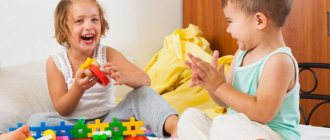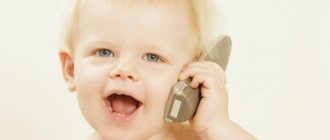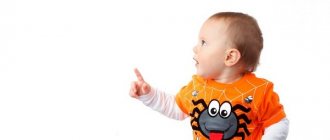Article:
A child’s speech at 2 years of age is actively formed against the background of the development of basic mental processes.
Thinking helps him compare objects with each other and establish simple connections. Increasing the stability of attention allows you to listen to stories or reading by an adult. Memory and perception are increasingly improved and make it possible to master the norms of the native language with great success. Listening to short fairy tales and short stories is already meaningful; a child can repeat after an adult complex words, simple phrases, and retell a small part on his own. In the second year of life, the baby is interested in everything that happens around him. He observes the objects of the surrounding world and masters the actions that can be performed with them. The main guides to the world of new information are adults from the immediate environment. But the baby can get help and new knowledge from them if he speaks. Communication with loved ones is the main incentive to master the native language between the ages of two and three years.
Features of speech development of children 2–3 years old
A two-year-old child has already mastered speech to such an extent that he can talk about his impressions, explain what he needs, and establish communication with peers and adults.
The normal development of a child’s speech at 2 years old leads to the fact that by the age of 2.5 years his vocabulary ranges from 1 thousand to 1200 words. This amount is 3-4 times more than the vocabulary with which he arrived at two years old. Most often he uses nouns (60% of the total vocabulary) and verbs (on average 25% of the total number of words). There are adjectives (about 10%), pronouns, prepositions, and adverbs.
Two-year-old children use participles, gerunds and numerals less often. By adjectives, child means:
- size of objects (large, small);
- color (green, red, blue, yellow, white, black);
- properties of objects (sweet, sour, cold, hot);
- qualities (good, bad);
- shape (round, square, triangular).
Generalizing words, such as toys, fruits, vegetables, clothes, furniture, dishes, animals, actively appear in the baby’s speech. He can also confuse objects from the same group, calling shoes and boots, and slippers, and even short boots, or the very concepts of vegetables and fruits. Lighter words (bi-bi instead of the word car) are becoming less and less common in a child’s speech.
Word creativity is actively developing, the baby comes up with words himself. Proof that at this age children are able to understand the sound side of a word can be seen in the textbook example given by Korney Chukovsky in his book “From Two to Five”: mazelin - Vaseline, mocress - compress.
Grammatical features of speech
The main content of children's speech at this age is simple narrative or exclamatory sentences. Complex sentences appear infrequently; their examples should be given in their speech by the baby’s parents. For example, “we won’t go for a walk today because it’s raining,” or “now we’ll read a book and then we’ll sleep.” Words in sentences in children of the third year of life are consistent in gender and number, but errors in case endings are often encountered.
Interrogative sentences are still asked by intonation, although children at this age are already able to use question words: where, why, when, how. You can suggest to your child: “Ask grandma where the car is?”, “Ask dad why the tea is hot?”, thereby giving examples of interrogative sentences.
Sound pronunciation
In the third year of a child’s life, the organs of pronunciation have become significantly stronger, the muscles of the tongue, lips, and lower jaw work more harmoniously. However, in the sound pronunciation of two-year-olds there are often many difficulties encountered, although the kids try to bring it as close as possible to the speech that sounds around them.
Most often, the pronunciation of hissing sounds suffers, which are replaced by whistling sounds, as they are easier in articulation (kasya - porridge, syapka - hat, koska - cat). Hard sounds can be replaced by soft ones (lapa - lyapa, dai - dyai), when consonants coincide, one of them is not pronounced, falls out, especially if these are sounds such as sh, zh, shch, ts, ch, l, r (stay - that , grass - tavka).
The child shortens words of 3-4 syllables, swaps syllables, and skips individual sounds, although in simple words he pronounces the same sounds flawlessly. The differences between the sound pronunciation of children of the same age by this period can be very significant. By the age of 3, some children master all the sounds of their native language, even the difficult-to-articulate sound p, while others have unclear speech with the absence of most sounds or no speech at all.
Year one
The first months of a child’s life are a time for emotional communication. The baby only listens to the sounds surrounding him from all sides and reacts to them with the help of facial expressions. Despite the fact that the baby does not understand speech yet, it is necessary to communicate with him. This not only evokes positive emotions in him, but also teaches him to listen, creates a desire to “speak” himself.
In the second or third month, emotions begin to translate into sounds. Seeing the mother, the baby not only perks up and expresses his joy with a smile and gestures, but also begins to “speak” in his own language - the humming stage begins. The “vocabulary” at this time is small and poorly understood: sounds and sound combinations like “e”, “khi”, “aaa”, “ha”, “gee”, etc. are in use. By the end of the 3rd - beginning of the 4th month, the humming intensifies - the baby begins to need to communicate. And by the end of the sixth month, the baby is already pronouncing individual syllables: pa, ma, ba, ga, etc. Repeated several times in a row, they form “words”: “mom,” “baba,” “dad.” Of course, this is not yet a full-fledged speech, but at the same time it is an important preparatory stage for its assimilation.
From 6 months, the baby not only pronounces sounds and syllables (babble), but also learns to repeat. The ability to establish a connection between a word and an object is formed. At 9-10 months the first words appear.
A particularly strong need to “talk” is caused by toys that the baby can call with onomatopoeic words: “Lala” (doll), “bi-bi” (car).
By 12 months, a child’s vocabulary contains an average of 10-12 words —easy to pronounce or onomatopoeic, but these are already full-fledged words—a means of communication.
Norm of speech development from 2 to 3 years
A child of this age, with whom his parents actively communicated and studied from the first months of life, can freely navigate his surroundings, knows the names of many objects and actions performed with them. The baby listens with interest to short fairy tales with a simple plot. He cannot yet retell them in full, but he is able to repeat individual phrases or words after an adult.
By the end of the third year of life, the baby is able to memorize short texts, complete rhymes that his parents read to him many times, and guess simple riddles with clues in the text. “Long tail, small legs, afraid of cats, squeaks “pee-pee-pee.” Who is this?" Although children's speech lacks a large number of correctly pronounced sounds, the baby's statements can be easily understood.
The level of speech development in children from 2 to 3 years old depends on the situation in which the child is located. Abstract categories denoted by words like friendship, illness, fear are inaccessible to his understanding. Grammatical errors in agreeing parts of speech are considered normal at this age. The phrases spoken by the baby are most often simple, although by the end of the third year additions and circumstances may appear in them: “The girl is riding a sled,” “The dog is running fast.”
The child asks questions, reproduces the intonation of adults’ speech, both as shown and independently. The child's voice is not yet strong, the baby is not able to control it fully. So, he cannot pronounce words louder if he is asked to do so, and whispering speech is also inaccessible to him.
Signs of speech delay
After two years, some children cannot use speech as a means of communication due to the fact that children’s speech development is delayed. The cause of concern for their parents is the complete absence of speech or a limited number of available words. In addition to a poor vocabulary, speech development delay (SDD) is expressed by the following symptoms:
- the child cannot translate his thought into a speech message, he finds it difficult to answer an adult’s questions;
- active and passive vocabulary accumulate at a very slow pace;
- children have difficulty constructing even a short phrase: “The girl’s ball fell or the girl’s ball” (The girl’s ball fell);
- Children cannot not only build a common sentence on their own, but also repeat it after an adult, for example, Teddy bear came out of the forest;
- in spoken words there are often rearrangements of syllables and sounds, substitution of one sound for another;
- when pronouncing individual sounds, the child notices tension or twitching of the facial muscles;
- he does not understand the meaning of a fairy tale or nursery rhyme read by an adult, and finds it difficult to answer a simple question about its content or try to retell it;
- The baby has difficulty assembling nesting dolls, cubes, and cut-out pictures consisting of four parts.
Why does a first-grader need a speech therapist: speech disorders and school work
Problems with speech development appear exclusively in childhood, and the last “chance” to encounter them is first grade. During this period, difficulties “preserved” from an early age can manifest themselves as dysgraphia (impaired written language) or dyslexia (impaired reading - the brain cannot transform incomprehensible graphic images into letters and, as a result, read the word correctly).
As a rule, these deviations become obvious by the end of the first grade. If a child has difficulty mastering competent writing and reading, he is inattentive (does not write the endings, starts writing from the second syllable, confuses the letters “d” and “b”, “m” and “n” and others), there is no point in hiring him a tutor. It is very possible that the issue is a speech deviation, which can be corrected with the help of speech therapy sessions.
Article provided by OsteoPolyClinic
Self-diagnosis of delay
It is better to plan diagnostic measures closer to the end of the third year of life. First, you need to carefully observe the child when he plays, in ordinary situations, when communicating with peers and adults. Attention is paid to the child’s vocabulary, ability to construct a phrase, and the number of words in sentences. It is important to note whether the child speaks quickly or slowly, since a fast rate of speech is a prerequisite for stuttering.
To check sound pronunciation, children are asked to name the objects shown in the pictures, rather than repeat the words after an adult. Otherwise, it will give a biased picture, since the child, imitating his elders, pronounces sounds better than usual. The presence of the following sounds is checked:
- whistling - s, z, c;
- hissing – w, w, h, shch;
- voiced – c, b, d, d;
- sonorous - l, r.
At the same time, they determine whether the baby rearranges syllables, misses sounds in words, or shortens the words themselves. To find out how a child constructs a phrase, he is offered pictures with the actions of familiar characters depicted on them: children, pets. You can use illustrations in children's books for these purposes. It is enough that the phrases composed by the child contain 2-3 words.
Developmental activities at home
Active communication with the child should begin immediately after birth. Even when he cannot yet babble clearly, eye contact is important; you introduce him to the world with the help of your gestures and intonation. This way you will develop emotional stability in him. Gradually he will compare the movements of the facial muscles and sounds.
At two years of age, to compensate for speech impairments, it is necessary to practice daily, while avoiding overwork or loss of interest. 10-20 minutes a day is enough, focus on your baby’s temperament. In addition to repeating words, you need to read children's books to improve your vocabulary. Riddle riddles with a rhyming answer. To achieve simple constructions or get a silent person to talk, study them according to topics and characteristics. In the same way, you can learn complex and long words: shop, so-baka, car, road, the parent starts, and the baby finishes. When working on imagination, it is necessary to expand the child’s horizons, ask him why a certain object is needed.
Games with animal sounds that can be portrayed in turns will be useful. Developing attentiveness, lay out toys on the table and quietly hide one at a time. Change roles with your baby periodically. To strengthen the muscles of the articulatory apparatus, you can do simple gymnastics, for example, making funny faces, stretching your mouth into a wide smile and stretching your lips in a tube.
Art creativity develops those areas of the brain that are responsible for speech functions. For the same purpose, you can play nursery rhymes, accompanying the story with hand movements (“Ladushki”, “We shared an orange”). To improve motor skills, let your baby work with plasticine, dough, buttons or beads. Of course, under your supervision to avoid accidental swallowing of small objects. On store shelves there is a large selection of children's educational books, manuals, toys, construction sets, where each parent can choose an activity according to their preferences. You can also diversify your leisure time with a trip to the zoo.








